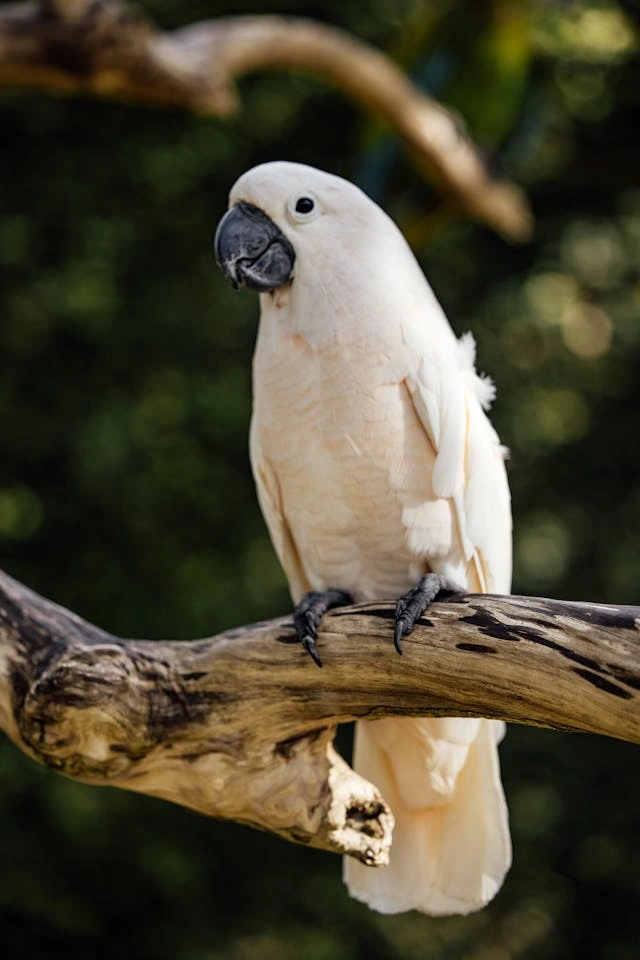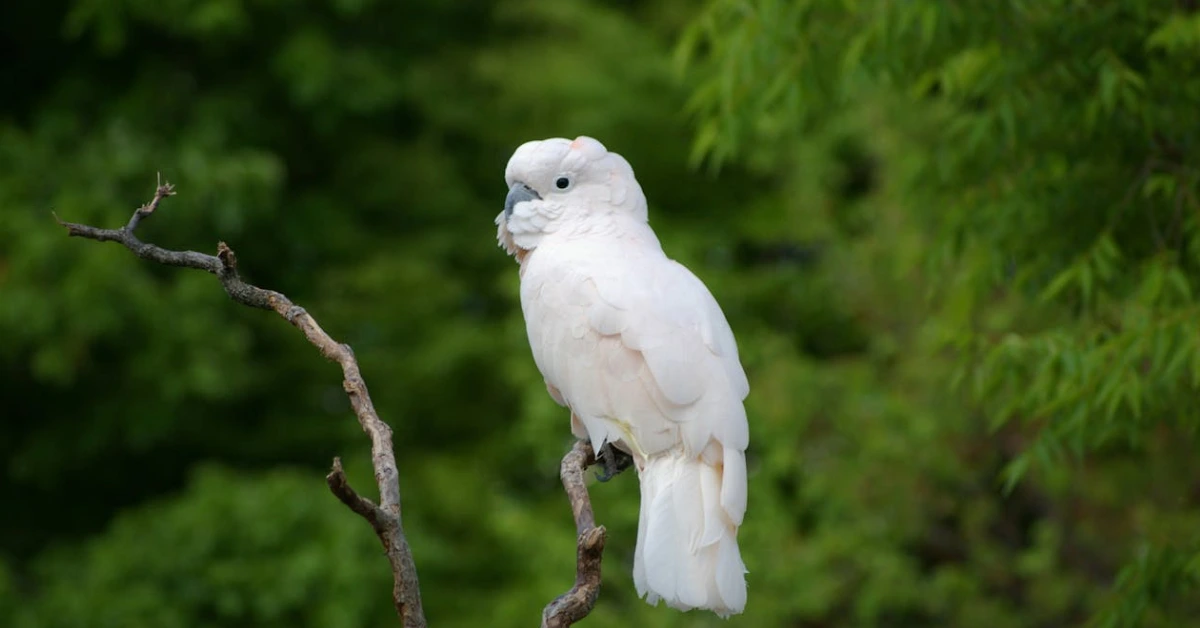A tempest of feathers and fervor, the Umbrella Cockatoo unleashes a presence that defies indifference. Cloaked in blazing white plumage and crowned by a crest that erupts like a solar flare, this Indonesian parrot embodies both wild elegance and raw emotional intensity.
Thriving in rainforest canopies, it forges lifelong bonds, communicates with theatrical flair, and mourns separation with a grief that echoes its human counterparts. Yet its dazzling charisma has made it a coveted companion, often at a devastating cost: captivity fractures its spirit, stripping away the freedom it needs to soar, scream, and love unapologetically.
This guide confronts the paradox of the Umbrella Cockatoo—a creature whose haunting vulnerability clashes with its fierce resilience—and argues that preserving its wild soul demands rethinking humanity’s role as both admirer and guardian.
Species Overview
Scientific Classification & Physical Traits
The Umbrella Cockatoo (Cacatua alba ) is instantly recognizable for its striking appearance. Its all-white plumage contrasts with subtle pale yellow accents on the undersides of its wings and tail. The species’ most defining feature is its broad, umbrella-shaped crest, which fans outward during communication or excitement. This crest serves as a visual signal to convey emotions like curiosity, alarm, or contentment. Sexual dimorphism is evident in eye color: males typically have dark brown or black irises, while females display reddish-brown hues.
Natural Habitat & Origin
Native to Indonesia’s Maluku Islands, including Halmahera, Bacan, and Ternate, these cockatoos thrive in diverse ecosystems. They inhabit lowland tropical forests, mangrove swamps—critical for nesting and feeding—and riverine forests near agricultural areas. However, their survival is threatened by rampant deforestation for logging and palm oil expansion, which destroys nesting sites and food sources. Illegal trapping for the pet trade persists despite CITES Appendix I protections, and rising sea levels from climate change further endanger mangrove habitats.
Lifespan & Conservation Status
In captivity, Umbrella Cockatoos can live 70–80 years or more with proper care, contrasting sharply with their wild counterparts. Classified as Vulnerable by the IUCN, wild populations have plummeted 30–49% since 1980 due to habitat loss and poaching. CITES Appendix I strictly regulates international trade, but enforcement gaps remain. Conservation efforts are urgent, requiring habitat restoration, anti-poaching measures, and global cooperation to ensure this species’ survival.

Temperament & Social Behavior
Affectionate Nature & Bonding
Umbrella Cockatoos form lifelong bonds, mirroring their wild mate-for-life instincts. As pets, they often develop intense attachments to their caregivers, thriving on consistent companionship. However, this deep connection can lead to separation anxiety when left alone. Signs of distress include excessive screaming, feather plucking, or territorial aggression. To nurture a healthy relationship, dedicate at least 1–2 hours daily to focused interaction, such as gentle handling, training, or quiet bonding time.
Vocalizations & Communication
While Umbrella Cockatoos lack advanced speech mimicry, they are highly vocal. Loud screeches are innate, serving as flock calls to signal alarms or maintain contact—traits that can clash with apartment living. Instead of speech, observe non-verbal cues: a raised crest signals excitement or curiosity, while hissing indicates discomfort. To manage noise, reward calm behavior with treats or praise, avoiding punishment, which exacerbates stress.
Social Needs & Flock Dynamics
As social creatures, Umbrella Cockatoos flourish in pairs or small groups, replicating their wild flock structure. Single pets require ample human interaction to prevent loneliness. Mimic flock activities through shared routines: scatter foraging toys for mental stimulation, engage in interactive play with destructible toys, or gently mimic preening by offering head scratches. These activities strengthen trust and fulfill their instinctual need for communal engagement.
Diet & Nutrition
Base Diet & Nutritional Balance
A balanced diet for Umbrella Cockatoos should consist of 80% high-quality pellets (e.g., Harrison’s or Roudybush) to ensure optimal nutrition. The remaining 20% should include fresh, nutrient-rich foods:
- Leafy greens : Kale, spinach, and dandelion greens for vitamins A and K.
- Vegetables : Carrots, bell peppers, and zucchini for fiber and antioxidants.
- Sprouts : Mung bean or alfalfa sprouts for enzymatic benefits.
- Grains : Cooked quinoa, millet, or amaranth for fiber and sustained energy.
Treats & Supplements
Offer treats in moderation to keep your Umbrella Cockatoo fit and avoid excess weight.
- Nuts : Unsalted almonds or walnuts (1–2 per week) for healthy fats.
- Seeds : Hemp, flaxseed, or chia seeds (in moderation) for omega-3 fatty acids.
- Avoid : Avocado (toxic), chocolate, caffeine, alcohol, and high-sugar fruits like grapes or bananas.
Hydration & Crop Health
Provide fresh, clean water in a heavy dish, changed twice daily to prevent bacterial growth. Monitor for signs of crop issues, such as regurgitation, delayed digestion, or reluctance to eat, which may indicate infection. Avoid feeding cold or spoiled foods, and ensure your bird drinks regularly to aid digestion.
Health & Wellness
Common Health Issues
- Feather Plucking : Often stems from stress, loneliness, or nutritional deficiencies. Address by enriching their environment, ensuring a balanced diet, and consulting a vet to rule out underlying issues.
- Psittacine Beak and Feather Disease (PBFD) : A contagious, incurable virus causing feather loss and beak deformities. Quarantine new birds for 30–60 days and test for PBFD before introducing them to existing pets.
- Fatty Liver Disease : Linked to high-fat diets and sedentary habits. Prevention includes limiting fatty seeds (e.g., sunflower) and encouraging active play.
Preventive Care & Vet Visits
- Schedule annual avian vet exams for blood tests, parasite checks, and grooming (beak/nail trims).
- Watch for emergency signs :
- Fluffed feathers (sign of illness).
- Labored breathing or wheezing.
- Sudden lethargy or loss of appetite.
- Keep a first-aid kit with styptic powder (for bleeding nails) and saline solution for eye rinses.
Managing Obesity & Liver Health
- Exercise : Encourage climbing, foraging, and supervised flight (if wings are unclipped). Wing-clipping decisions should balance safety and natural movement.
- Diet : Prioritize low-fat pellets and fresh veggies. Avoid overfeeding nuts, seeds, or sugary fruits. Control serving sizes to support a balanced, healthy weight.
Training & Enrichment
Trick Training & Mental Stimulation
Umbrella Cockatoos excel at learning simple tricks, which strengthen trust and provide mental engagement. Start with basics like “step up,” “wave,” or fetching small objects, using treats and praise as rewards. Opt for brief 5–10 minute sessions to sustain your cockatoo’s attention. Introduce foraging games by hiding treats in shredded paper, cardboard boxes, or puzzle feeders. These activities mimic natural foraging behaviors, reducing boredom and encouraging problem-solving.
Noise Control & Behavioral Management
To manage loud vocalizations, redirect attention by rewarding calm moments with treats or interaction. Avoid shouting or punishment, as this escalates anxiety and erodes trust. Instead, ignore unwanted noise briefly, then reinforce quiet behavior. Identify triggers for screaming (e.g., loneliness, boredom) and address them with enrichment or companionship. Consistency is key to reshaping communication habits.
Bonding Activities
Build trust by letting your cockatoo initiate cuddling or physical contact. Respect their boundaries to avoid stress. Foster connection through shared activities:
- Dancing or bobbing to music together.
- Singing or whistling interactive tunes.
- Outdoor exploration using a secure harness and leash for supervised adventures.
These experiences deepen your bond while satisfying their social and exploratory instincts.

Adoption & Conservation
Choosing a Responsible Breeder
Opt for breeders who prioritize ethics over profit. Responsible breeders provide transparency about a bird’s lineage, health history, and living conditions, and they never source from wild-caught populations. Visit facilities in person to ensure birds are housed in spacious, clean environments. Avoid breeders who refuse visits, keep birds in overcrowded cages, or lack knowledge about species-specific care.
Rescue Organizations & Rehoming
Adopting a rescued Umbrella Cockatoo offers a lifeline to birds abandoned due to behavioral or health challenges. Reputable organizations include:
- Center for Avian Rescue, Adoption, and Education (CARE) : Focuses on rehabilitating surrendered parrots.
- Phoenix Landing Foundation : Provides lifelong care and adoption support for parrots in need.
Rescues often screen adopters to ensure compatibility, ensuring a forever home for these long-lived birds.
Conservation Efforts
Habitat Protection :
- Support NGOs like Rainforest Trust funding reforestation in Indonesia’s Maluku Islands, restoring critical cockatoo habitats.
- Choose RSPO-certified sustainable palm oil to reduce deforestation pressure on tropical ecosystems.
Anti-Poaching :
- Report illegal wildlife trade via CITES reporting channels or apps like WildLeaks .
- Donate to ProFauna Indonesia , which trains rangers and enforces anti-poaching laws to protect wild populations.
Individual actions—from mindful consumer choices to supporting conservation programs—play a vital role in securing the future of Umbrella Cockatoos in the wild.
Related Species & Further Research
Similar Cockatoo Species
- Sulphur-Crested Cockatoo (Cacatua galerita ) : Larger than Umbrella Cockatoos, with a striking yellow crest and louder, more frequent vocalizations. Requires even more social interaction.
- Goffin’s Cockatoo (Cacatua goffiniana ) : Smaller in size but equally intelligent, known for problem-solving skills and playful demeanor. Less prone to loud screeching compared to Umbrella and Sulphur-Crested species.
Resources for Bird Enthusiasts
- Books :
- Parrots of the World by Joseph Forshaw: A definitive guide to parrot species, including detailed profiles on cockatoos and their natural behaviors.
- Organizations :
- World Parrot Trust : Offers research, conservation grants, and educational resources to protect parrots globally.
- BirdLife International : Partners with local communities to safeguard habitats and advocate for threatened species like the Umbrella Cockatoo.
Explore these resources to deepen your understanding of cockatoo conservation, behavior, and ethical care practices.
Conclusion
The Umbrella Cockatoo’s captivating personality and striking appearance make it a cherished companion, but its needs are profound and lifelong. From daily social bonding and mental enrichment to a diet and environment that mirror its wild instincts, this species demands dedication. As deforestation and illegal trade threaten wild populations, responsible ownership—choosing adoption, supporting ethical breeders, and advocating for conservation—becomes an act of stewardship.
By supporting organizations like the World Parrot Trust or Rainforest Trust, you contribute to habitat protection and anti-poaching efforts critical to their survival. Share knowledge about their plight to inspire collective action. Remember: “Owning an Umbrella Cockatoo isn’t a hobby—it’s a lifetime commitment to a wild heart in a domestic world.” Their future depends on the choices we make today.
